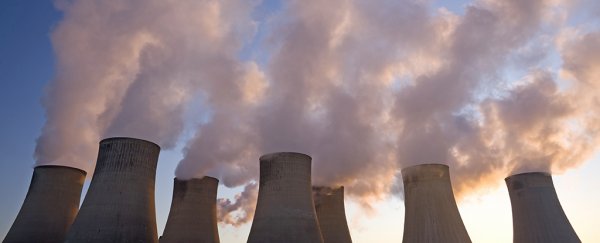We're so far down the road of climate change, that even making drastic cuts to atmospheric carbon dioxide levels won't be enough for the world's weather systems to fall back into their previous patterns, according to a new study.
But the research also suggests we still can have a huge impact on how severe that change will be.
Through a series of advanced climate model simulations, researchers looked at the effect of ramping up CO2 levels to 1,468 ppm – four times their current level – over the course of the next 140 years, then bringing them all the way back down to where they are today across another 140 years.
What they found was that as CO2 levels began to fall back down, the Intertropical Convergence Zone (ITCZ) – responsible for 32 percent of global rainfall – shifts southwards, potentially causing a permanent change to El Niño-style conditions.
The team behind the modeling points out that these irreversible changes in weather systems need to be factored into climate change planning, alongside the more common predictions around temperatures and rainfall on a global scale.
"It is impossible to properly reflect the complex climate system if only the average global temperature and precipitation levels are considered when creating mitigation policies to prevent climate change, such as carbon neutrality or carbon reduction," says environmental scientist Jong-Seong Kug, from the Pohang University of Science and Technology in South Korea.
Whereas previous studies suggest that temperature and precipitation might eventually get back to where they are now – albeit over several hundred years – the new research suggests the knock-on effects of shifting climate change aren't so clear.
In some parts of the world, climate change would be permanent even as CO2 levels dropped, these latest models show. North and South America were shown to have a 15 percent increase in precipitation, for example, risking more flooding even after CO2 levels dropped significantly.
Meanwhile, the Sahel zone – which includes southern Europe and the Sahara Desert – experienced a 20 percent decrease in annual precipitation even after a carbon dioxide reset, which would be likely to lead to further desertification.
"The already emitted greenhouse gases have lasting effects on the planet so we need to recognize their long-term impacts as well as their immediate effect on climate change," says Kug.
As the ITCZ shifts, it can have significant and far-reaching effects. For example, it can alter the Hadley circulation, the foundation for atmospheric circulation for the whole planet (starting with warm air rising at the equator).
What the researchers have found is that the ITCZ is likely to stay in the Southern Hemisphere after a CO2 rise, even if the CO2 levels then drop. While the Northern Hemisphere would cool down as atmospheric carbon dioxide falls, the Southern Hemisphere is predicted to remain warm – similar to the weather patterns we experience during El Niño years.
Modeling climate change is incredibly complicated, but the more data we have, the better our preparations and mitigations can be – and it is of course another warning about the urgency of keeping CO2 emissions down to a minimum.
"Our study shows that the effects of CO2 that have already taken place will persist for longer than expected and that future CO2 emissions will bring about further delayed and irreversible effects," write the researchers in their published paper.
The research has been published in Nature Climate Change.
